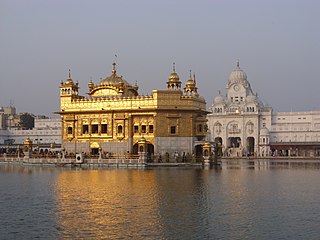
Kangra district is the most populous district of the Indian state of Himachal Pradesh. Dharamshala is the administrative headquarters of the district.

West Tripura is an administrative district in the state of Tripura in India. The district headquarters are located at Agartala. As of 2012 it is the most populous district of Tripura.

Darjeeling District is the northernmost district of the state of West Bengal in eastern India in the foothills of the Himalayas. The district is famous for its hill station and Darjeeling tea. Darjeeling is the district headquarters.

Amritsar district is one of the twenty three districts that make up the Indian state of Punjab. Located in the Majha region of Punjab, the city of Amritsar is the headquarters of this district.

Sri Ganganagar is the northernmost city of the Indian state of Rajasthan, near the international border of India and Pakistan. It is the administrative headquarters of Sri Ganganagar district. It is named after Maharaja Shri Ganga Singh Bahadur, Maharaja of Bikaner. The city is also known as the "Food Basket of Rajasthan".

Firozpur, also known as Ferozepur, is a city on the banks of the Sutlej River in Firozpur District, Punjab, India. After the partition of India in 1947, it became a border town on the India–Pakistan border with memorials to soldiers who died fighting for India.

Bathinda district is in Malwa region of Punjab, India. The district encompasses an area of 3,385 square kilometers. By area, Bathinda district is the second-largest in Punjab, after Ludhiana district. It is bounded by Faridkot district and Moga district on the north, Muktsar district on the west, Barnala and Mansa districts on the east, and the state of Haryana on the south. Bathinda is cotton producing belt of Punjab.

Sirsa is a city and a municipal council in Sirsa district in the westernmost region of the Indian state of Haryana, bordering Punjab and Rajasthan. It is located near to Thar desert or we can say a small portion of Sirsa is under Thar Desert. It is located 250 kilometres north-west of New Delhi and 260 kilometers south-west of state capital Chandigarh. Sirsa Nearest city Hisar, Fatehabad, Bhadra, Nohar, Mandi Dabwali, Hanumangarh. Its history dates back to the time of the Mahabharata. At one time, the Sarasvati River flowed in this area.

Firozpur district, also known as Ferozepur district, is one of the twenty-three districts in the state of Punjab, India. Firozpur district comprises an area of 2,190 km2 (850 sq mi).

Hanumangarh district is a district in the state of Rajasthan in India. The city of Hanumangarh is the district headquarters and its largest city.

Fazilka, also known as Bangla, is a city and a municipal council in Fazilka district of Punjab, India. In 2011, it was made the headquarter of the newly created Fazilka district. The Trans-Afghanistan Pipeline (TAPI) project originating in Turkmenistan will have its last station in Fazilka.
Maharajganj is a town and municipal board in Maharajganj district in the Indian state of Uttar Pradesh.

Shopian or Shupiyan ,, known as Shupyan in Kashmiri, is an administrative division of the Shopian district, located in southern part of Kashmir Valley, of Jammu and Kashmir, India. Shopian is called the ''Apple town of Kashmir'' as majority of the population engages in apple growing practices which also provides employment to more than 60% of the population. It is 2nd richest district in Kashmir region after Srinagar.
Vita, also known as Vite, is a town and a municipal council in Sangli district in the Indian state of Maharashtra. Vita is also taluka headquarters of Khanapur taluka.
Kandhwala or Kandhwala HazarKhan is a village located in the Fazilka district of Punjab, India. The village falls under Tehsil of Fazilka district.
Bishanpura is a village in the notified area of Zirakpur in Mohali district, Punjab, India.

Fazilka district is one of 23 districts in the state of Punjab in India. The district headquarters of the Fazilka District are at Fazilka.

Pathankot district is the northernmost district of the Indian state of Punjab. Pathankot is the district headquarters. The district was created on July 27, 2011.
Abohar Wildlife Sanctuary earned the status of a sanctuary in 1975 and again in 2000 under the Wildlife Protection Act 1972. It is located in the Fazilka district of Punjab and is a private nature reserve. It is known for being a preservation hotspot for Black Buck, which is regarded as a sacred animal by the people of Bishnoi community who are native to the place.














